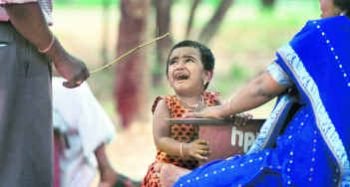A scene at a supermarket: The child screams, "I want that! I want that!" The mother shouts at her son, threatens him and then, for good measure, whacks him.
A scene at home: A father's voice is raised. He is annoyed with his daughter. "Get out of my sight. I don't want to see you. You are disgusting."
According to Save the Children, physical and humiliating punishment (PHP) is violence against children that is done with the aim of controlling or educating the child. Yet, it violates children's rights in very serious ways. "Many children say that physical and humiliating punishment occurs more at home than in any other place. Children say they do not know where to go for help, when they are hit at home." This is reflected in the ongoing study on `Children's Perception on Parenting' being conducted by Save the Children Sweden, Regional Office for South and Central Asia.
"Children say when there is violence in school they can complain to their parents or the principal, but where do they go when they are beaten at home? Sometimes parents tell the teachers to beat the children if they are naughty or not serious about their studies. Some parents are even afraid to confront the teachers if the teachers are physically or verbally abusing their children," says Shoma Jabeen, Regional Advisor, Adult Support and Violence Against Children, Save the Children. Physical and humiliating punishment is common the world over. What most parents fail to realise is that there is a difference between punishment and discipline.
While discipline is necessary to educate and bring up a child, it is also an educative tool. There is no power struggle as norms and limits are set in consultation with the child.
Their Right
The UN Convention on the Rights of the Child (UNCRC) says that children have the right to be consulted on decisions that affect them, and this includes discipline at home and in school. But the problem arises when children are scared of PHPand they do not voice what they think. It is important to try and understand what children have to say because physical and humiliating violence sends out the message that it is all right for a stronger person to use violence against a weaker person. And this often sows the seed of violence that manifests in the adult.
Punishment is actually an absence of power whereas discipline is a tool of authority. The line between discipline and punishment is thin and when this is crossed it becomes violence.
What then is a positive discipline method? First, it should always question the behaviour of the child, not his/her dignity. It is most effective when rules and norms are set in consultation with children.
Adults need to remember that you gain authority only when you give power to children. Most often punishment is the easiest thing to hand out.
You can change the meaning of a positive discipline tool toward a punishment depending on the way you apply the norm.
But probably the last word on this would be the finding that physical and psychological punishment is especially harmful to the child because people who are close to them and those whom they love often commit them.
Forms of physical and humiliating punishment:
Includes hitting the child with the hand or with an object, kicking, shaking or throwing the children, pinching and pulling their hair, forcing the child to stay in an uncomfortable or embarrassing position or to take too much physical exercise.
Humiliating punishment includes verbal abuse (namecalling) making children feel bad, mocking them or isolating them.
Source: The Hindu


No comments:
Post a Comment